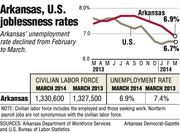Arkansas’ unemployment rate fell to 6.9 percent in March, the first time it’s been below 7 percent since it was 6.8 percent in January 2009, the U.S. Bureau of Labor Statistics said Friday.
The rate dropped from 7.1 percent in February.
The nation’s unemployment rate in March was 6.7 percent.
Economists were pleased with the decline in Arkansas’ unemployment rate, especially after a 0.2 percentage-point decline from January to February.
The drop below 7 percent was more important psychologically than anything else, said Greg Kaza, executive director of the Arkansas Policy Foundation.
“You would expect the unemployment rate this far into a recovery to be falling month to month,” Kaza said.
Statistically, the unemployment rate has not changed, said Kathy Deck, director of the Center for Business and Economic Research at the University of Arkansas at Fayetteville. The statistical margin of error in calculating the unemployment rate in Arkansas is 0.9 percentage point, according to the Bureau of Labor Statistics in Dallas.
“But it’s wonderful to see us go below that 7 percent level,” Deck said. “We’ve had several good months of information in a row.”
In 2011 and 2012, Arkansas’ unemployment rate was in the 8 percent range, Deck said.
“Then we were consistently at 7.5, 7.6, 7.7 [percent],” Deck said. “Now we’re sitting around 7.1, 7.2, 6.9 [percent]. That shows the gradual improvement we’re talking about.”
Over the past few months, the national unemployment rate has been stagnant and Arkansas’ unemployment rate has been dropping, said Marc Fusaro, associate professor of economics at Arkansas Tech University.
“In August, Arkansas’ rate was 7.7 percent,” Fusaro said. “And the federal rate was [7.3percent]. Since then, Arkansas dropped by almost [1 percentage point].”
March was the seventh consecutive month that several economic indicators in Arkansas moved in a positive direction, said Michael Pakko, chief economist at the Institute for Economic Advancement at the University of Arkansas at Little Rock.
Employment has increased for seven months and the number of unemployed has fallen over the same period, Pakko said.
“August last year was when things really started to turn a corner,” Pakko said.
Another indicator of an improved economy is that the growth in employment appears to be more broad-based throughout the state than it appeared last year, Deck said.
“There seemed to be some initial disparity [last year] among regions, with Northwest Arkansas and Jonesboro really seeming to be flying high, Little Rock and Fort Smith doing OK and everybody else in the dumps,” Deck said. “The revised statistics fortunately brought everybody closer together. So now it looks like the state is moving more solidly together.”
Pakko said he now expects Arkansas’ unemployment rate to fall as low as 6.5 percent by the end of this year and possibly drop below 6 percent at the end of 2015.
The most encouraging sector of the economy was construction, which has added 1,600 jobs since March last year. Last month, there were 46,900 Arkansans working in construction. The sector had been lagging until recent months.
“Construction had been the one sector that we expected to come back that really hadn’t,” Pakko said. “That is because the collapse of the housing market was such an important feature of the recession we went through. Uncharacteristically, construction has been very slow to recover. Now we’re finally seeing some rebound in construction employment in recent months.”
Richard Hedgecock, the executive vice president of the Arkansas chapter of Associated General Contractors of America, said highway-improvement initiatives are accounting for significant increases in construction employment.
And in recent months, commercial construction finally has begun to improve, both in central Arkansas and in Northwest Arkansas, Hedgecock said.
“The private sector has continued to be the laggard here in Arkansas,” Hedgecock said. “Particularly in central Arkansas. Northwest Arkansas has done a little bit better. But some of my members in the central part of the state say they are now dealing with a flurry of activity. Both [areas] of the state are now on the rise.”
His association represents highway contractors, commercial contractors and underground contractors, Hedgecock said.
Rhode Island had the highest unemployment rate in the country at 8.7 percent, followed by Nevada at 8.5 percent, Illinois at 8.4 percent, California at 8.1 percent and Kentucky at 7.9 percent.
North Dakota again had the lowest unemployment rate at 2.6 percent, followed by Vermont at 3.4 percent, South Dakota and Nebraska at 3.7 percent each and Wyoming at 4 percent.
Front Section, Pages 1 on 04/19/2014
